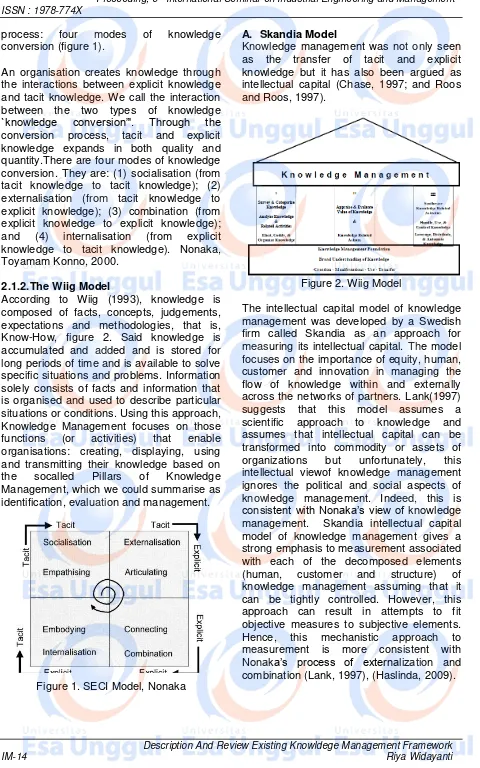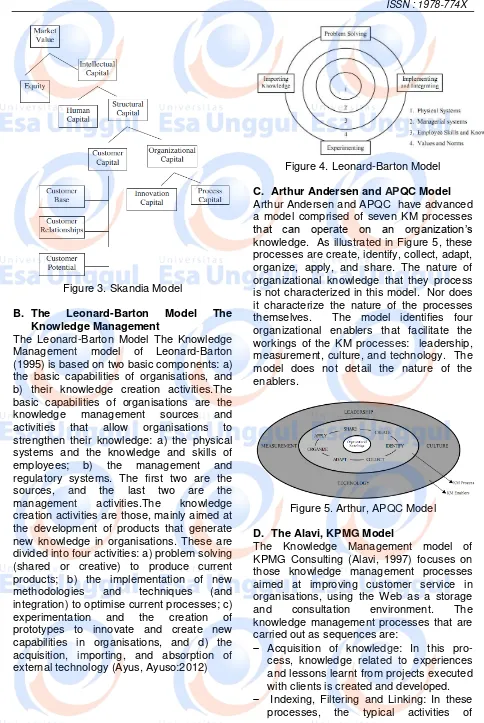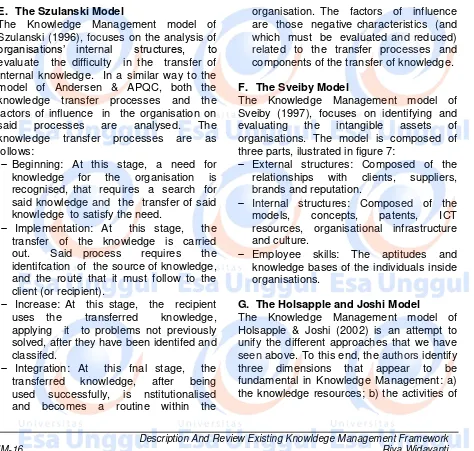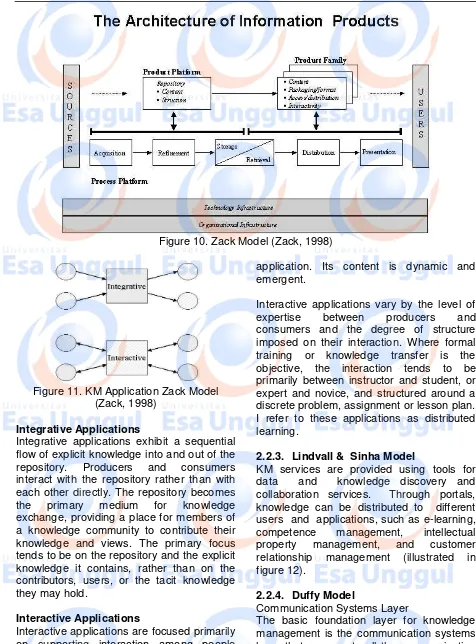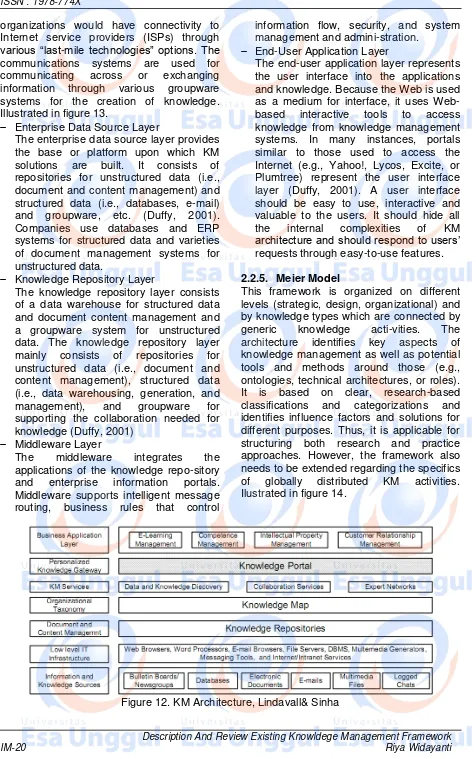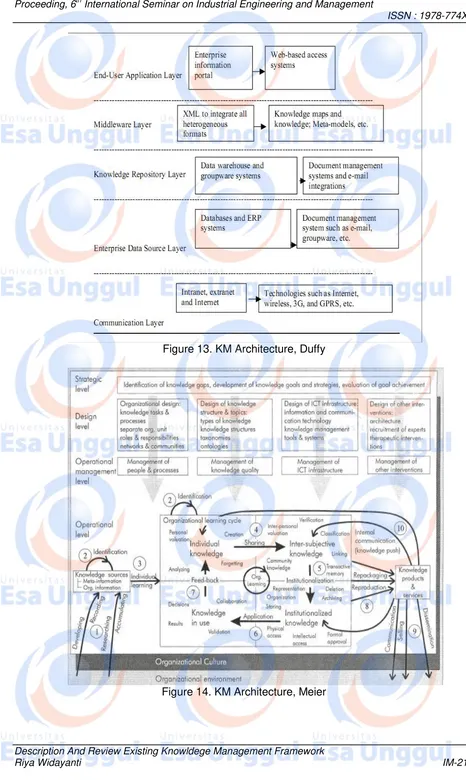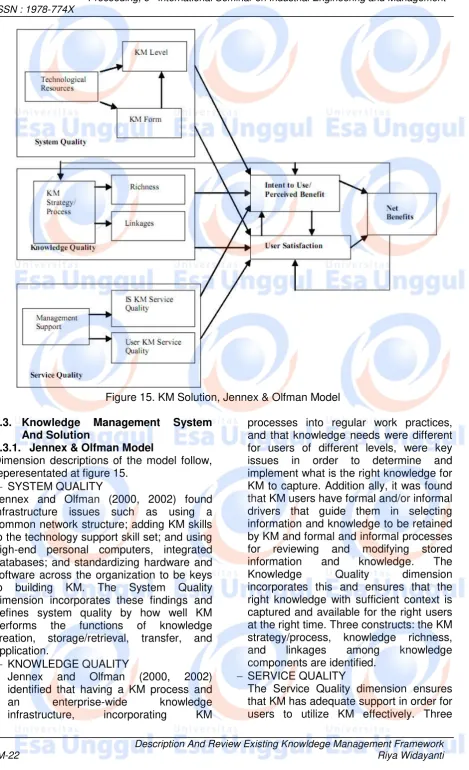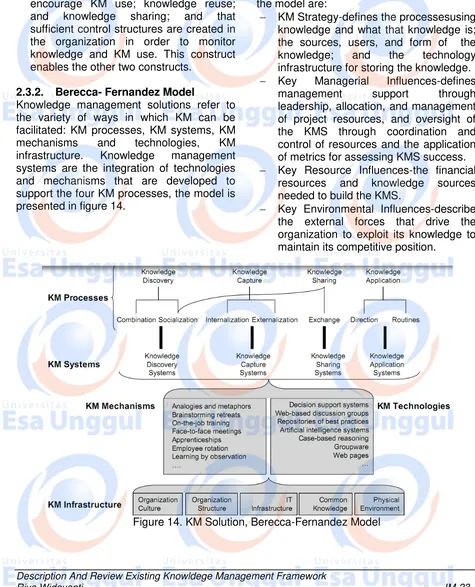R E V I E W E R
1.
Prof. Ir. I Nyoman Pujawan, MEng, PhD
(Sepuluh Nopember Institute of Technology, INDONESIA)
2.
Prof. Ahmad Syamil, Ph.D.
(Arkansas University, USA)
3.
Prof. Erry YT Adesta, Ph.D.
(International Islamic University of Malaysia, MALAYSIA)
4.
Assoc.Prof. Dr. Chuvej Chansa-Ngavej
(Shinawatra University, THAILAND)
5.
Dr. Ir. Sri Gunani Pertiwi, MT.
(Sepuluh Nopember Institute of Technology, INDONESIA)
6.
Dr. Dadang Surjasa, SSi, MT
(Trisakti University, INDONESIA)
7.
Dr. Ir. Triwulandari SD, MM
(Trisakti University, INDONESIA)
8.
Dr. Ir. Lily Amelia, M.Agr., M.M.
(Esa Unggul University, INDONESIA)
9.
Dr. Ir. Nofi Erni, M.M.
(Esa Unggul University, INDONESIA)
10. Prof. Dr. Hadi Sutanto
(Atma Jaya Jakarta Catholic University, INDONESIA)
11. Prof. Dr. Weggie Ruslan
(Atma Jaya Jakarta Catholic University, INDONESIA)
12. Prof. Dr. Ir. S. Sardy, M.Eng.Sc
(Al Azhar Indonesia University, INDONESIA)
13. Dr. Ir. Hj. Tjutju Tarliah Dimyati, MSIE
(Pasundan University, INDONESIA)
14. Dr. Ir. Hj. Arumsari, MSc
(Pasundan University, INDONESIA)
15. Dr. Lamto Widodo ST. MT
DESCRIPTION AND REVIEW EXISTING KNOWLDEGE MANAGEMENT
FRAMEWORK, SYSTEM, TECHNOLOGY AND ARCHITECTURE
Riya Widayanti
Computer Science Faculty, Esa unggul University, Jakarta, Indonesia E-mail : riya.widayanti@esaunggul.ac.id
ABSTRACT
There is a growing recognize in the organizatinon and community about importance of managing knowledge. Some organizations have taken initiatives to improve and manage the resources. The resources need to be managed and protected in order to sustain and grow a business. There are several management perspectives that are being used when designing these knowledge system. Those include people, culture, structure, and technology. Firstly, the authors will present their view
regarding knowledge management, which is a framework and technological perspective. Seondly, the authors will analyse the characteristics of knowledge as the object to be managed and will identify, analyse and criticise the most relevant knowledge management approaches, models and methodologies related to their objectives, then outlining the requirements that technological knowledge management .
Key words : Knowledge management framework, knowledge management technology and architectur
1. INTRODUCTION
In the last decades, knowledge management (KM) has captured enterprises’ attention as one of the most promising ways to reach success in this information era (Malone, 2002). A shorter life cycle of products, globalization, and strategic alliances between companies demand a deeper and more systematic organizational knowledge management (Vizcaíno, 2007). So many knowledge management solution to develop and create s framework. In this paper author want to desriptive existing knowledge management framework and technology approch, and give a summary about these. However, developing KMS is a diffcult task; since knowledge per se is intensively domain dependent whereas KMS often are context specifc applications. Thus, reusability is a complex issue. On the other hand, the lack of sophisticated methodologies or theories for the extraction of reusable knowledge and reusable knowledge patterns has proven to be extremely costly, time consuming, and error prone (Gkotsis, Evangelou, Karacapilidis & Tzagarakis, 2006). Moreover, there are several approaches towards KMS developing. For instance, the process/task
based approach focuses on the use of knowledge by participants in a project, or the infrastructure/generic system based approach focuses on building a base system to capture and distribute knowledge for use throughout the organization (Jennex, 2005). The main objective of this paper is to review the evolution and development of KM framework and technology models in terms of focus of each model.
2. KNOWLEDGE MANAGEMENT APPROACHES
2.1. Knowledge Management Frameworks
2.1.1. Nonaka Model
process: four modes of knowledge conversion (figure 1).
An organisation creates knowledge through the interactions between explicit knowledge and tacit knowledge. We call the interaction between the two types of knowledge `knowledge conversion”'. Through the conversion process, tacit and explicit knowledge expands in both quality and quantity.There are four modes of knowledge conversion. They are: (1) socialisation (from tacit knowledge to tacit knowledge); (2) externalisation (from tacit knowledge to explicit knowledge); (3) combination (from explicit knowledge to explicit knowledge); and (4) internalisation (from explicit knowledge to tacit knowledge). Nonaka, Toyamam Konno, 2000.
2.1.2. The Wiig Model
According to Wiig (1993), knowledge is composed of facts, concepts, judgements, expectations and methodologies, that is, Know-How, figure 2. Said knowledge is accumulated and added and is stored for long periods of time and is available to solve specific situations and problems. Information solely consists of facts and information that is organised and used to describe particular situations or conditions. Using this approach, Knowledge Management focuses on those functions (or activities) that enable organisations: creating, displaying, using and transmitting their knowledge based on the socalled Pillars of Knowledge Management, which we could summarise as identification, evaluation and management.
Figure 1. SECI Model, Nonaka
A. Skandia Model
Figure 2. Wiig Model
Figure 3. Skandia Model
B. The Leonard-Barton Model The Knowledge Management
The Leonard-Barton Model The Knowledge Management model of Leonard-Barton (1995) is based on two basic components: a) the basic capabilities of organisations, and b) their knowledge creation activities.The basic capabilities of organisations are the knowledge management sources and activities that allow organisations to strengthen their knowledge: a) the physical systems and the knowledge and skills of employees; b) the management and regulatory systems. The first two are the sources, and the last two are the management activities.The knowledge creation activities are those, mainly aimed at the development of products that generate new knowledge in organisations. These are divided into four activities: a) problem solving (shared or creative) to produce current products; b) the implementation of new methodologies and techniques (and integration) to optimise current processes; c) experimentation and the creation of prototypes to innovate and create new capabilities in organisations, and d) the acquisition, importing, and absorption of external technology (Ayus, Ayuso:2012)
Figure 4. Leonard-Barton Model
C. Arthur Andersen and APQC Model
Arthur Andersen and APQC have advanced a model comprised of seven KM processes that can operate on an organization’s knowledge. As illustrated in Figure 5, these processes are create, identify, collect, adapt, organize, apply, and share. The nature of organizational knowledge that they process is not characterized in this model. Nor does it characterize the nature of the processes themselves. The model identifies four organizational enablers that facilitate the workings of the KM processes: leadership, measurement, culture, and technology. The model does not detail the nature of the enablers.
Figure 5. Arthur, APQC Model
D. The Alavi, KPMG Model
The Knowledge Management model of KPMG Consulting (Alavi, 1997) focuses on those knowledge management processes aimed at improving customer service in organisations, using the Web as a storage and consultation environment. The knowledge management processes that are carried out as sequences are:
Acquisition of knowledge: In this pro-cess, knowledge related to experiences and lessons learnt from projects executed with clients is created and developed. Indexing, Filtering and Linking: In these
library management are carried out, such as the emission, classifcation, addition and interconnection of knowledge from different sources from those from which it has been acquired in the process of Acquisition.
Distribution: In this process, the grouping and delivery of knowledge is carried produce improvements in the products and services of the organisation.
Figure 6. Alavi model
Figure 7. Sveiby Model
E. The Szulanski Model
The Knowledge Management model of Szulanski (1996), focuses on the analysis of organisations’ internal structures, to evaluate the difficulty in the transfer of internal knowledge. In a similar way to the model of Andersen & APQC, both the knowledge transfer processes and the factors of influence in the organisation on said processes are analysed. The knowledge transfer processes are as follows:
Beginning: At this stage, a need for knowledge for the organisation is recognised, that requires a search for said knowledge and the transfer of said knowledge to satisfy the need.
Implementation: At this stage, the transfer of the knowledge is carried out. Said process requires the identifcation of the source of knowledge, and the route that it must follow to the client (or recipient).
Increase: At this stage, the recipient uses the transferred knowledge, applying it to problems not previously solved, after they have been identifed and classifed. are those negative characteristics (and which must be evaluated and reduced) related to the transfer processes and components of the transfer of knowledge.
F. The Sveiby Model
The Knowledge Management model of Sveiby (1997), focuses on identifying and evaluating the intangible assets of organisations. The model is composed of three parts, ilustrated in figure 7:
External structures: Composed of the relationships with clients, suppliers, brands and reputation.
Internal structures: Composed of the models, concepts, patents, ICT resources, organisational infrastructure and culture.
Employee skills: The aptitudes and knowledge bases of the individuals inside organisations.
G. The Holsapple and Joshi Model
knowledge management; and c) the factors of influence.
In the study by Hoslapple and Joshi, it is shown that none of the models that we have seen so far include all of the three specified dimensions. What can be seen is that each one of them is interested in a specific dimension, focussing metho-dology towards resources, activities or the factors of influence.
Regarding the knowledge resources, the Leonard-Barton model is the only one that considers them in a special way, classifying them into two types: employee knowledge and knowledge from physical systems. As ilustrated in figure 8.
Regarding the activities of knowledge management, the majority of the models explicitly consider said activities.
From the study carried out, Holsapple & Joshi establish a model of three levels (or dimensions):
Knowledge Resources: These are the sources of knowledge in organisations. Knowledge Activities: These are the
processes that establish the handling of knowledge.
Factors of Influence: These are the elements of organisations that could support or hinder the knowledge activities in organisations.
2.1.3. CEN Model
One of the main frameworks currently used in practice is the framework by CEN (2004) created in the European standar-dization community. It provides a common terminology and frame of reference for organizations involved in knowledge management (Figure 8). The CEN frame-work shows a clear process orientation, aiming at describing core business processes as well as knowledge-related processes. It extends those processes by enablers: knowledge capabilities on an organizational (e.g., vision, strategy) and individual level (such as skills, competences, methods, tools). This framework has created a common terminology and structure as well as guidelines around those. However, it does not cover the main aspects of globally distributed KM but provides extension options, such as extending processes or adding enablers and additional compo-nents. It also does not incorporate the
research perspectives (e.g., aspects studied or models validated). However, due to its relevance to practice, it is a good candidate to be used as a basis for a global framework.
2.2. Knowledge Management Technology and Architecture
2.2.1. Kerschberg & Weishar Model
Based on the Conceptual Model of Kerschberg & Weishar (2002), we show the components of a Corporate Knowledge System that are defined in the middle layer, based on the Business Model and the goals established by the Strategic Management, which we can divide into two subgroups: Services Based on Knowledge and on Unstructured Information, and Services Based on Standardised Processes and Structured Information. Within each of the subgroups we can find the following services:
Knowledge Based Services and Unstructured Information (KBS-UI).
These services are aimed at the needs of organisations relating to knowledge: the Business Intelligence for the monitoring of competitive processes, the Knowledge Engineering for the modelling of the inten-sive knowledge processes and the culture of organisations, as well as the manage-ment needs of the unstructured informa-tion, which is usually 80% of the total in Data Mining for Business Intelligence; Knowledge Based Systems (KBS) and Knowledge Engineering (KE) to manage the intensive knowledge processes (Intelligent Agents in Generic Tasks), the culture of the organisation (Corporate Reports), and developing Intelligent Agents that can be used for Learning, Information Retrieval Systems (IRS) combined with Document Based Management Systems (DBMS) to optimise the use of unstructured infor-mation in organisations, and Collaborative Work Systems (CWS) to support the group processes within organisations. Services Based on Standardised
the needs of organisations relating to standardised processes: Finance, Customer Relations, Production, Logistics and Products; using automation through the Work Flow, as well as the multi-platform of the WEB environment. All of this based on the structured information of organisations.
2.2.2. Zack model
The management of explicit knowledge utilizes four primary resources (Figure 10): Repositories of explicit knowledge;
Refineries for accumulating, refining, managing, and distributing that knowledge;
Organization roles to execute and manage the refining process; and
Information technologies to support those repositories and processes.
The Knowledge Repository
The design of a knowledge repository reflects the two basic components of knowledge as an object: structure and content. Knowledge structures provide the context for interpreting accumulated content. If the repository is conceived as a "knowledge platform", then many different views of the content may be derived from a particular repository structure. A high degree
of viewing flexibility enables users to alter and combine views dynamically and interactively and to more easily apply the knowledge to new contexts and circumstances. At a Classification of Knowledge Management Applications Based on this knowledge management architecture, knowledge processing can be segmented into two broad classes: integrative and interactive (Figure 11), each addressing different knowledge management objectives. Together, these approaches provide a broad set of knowledge processing capabilities. They support well-structured repositories for managing explicit knowledge while enabling interaction to integrate tacit knowledge.
Figure 8 Cen KM
Figure 10. Zack Model (Zack, 1998)
Figure 11. KM Application Zack Model (Zack, 1998)
Integrative Applications
Integrative applications exhibit a sequential flow of explicit knowledge into and out of the repository. Producers and consumers interact with the repository rather than with each other directly. The repository becomes the primary medium for knowledge exchange, providing a place for members of a knowledge community to contribute their knowledge and views. The primary focus tends to be on the repository and the explicit knowledge it contains, rather than on the contributors, users, or the tacit knowledge they may hold.
Interactive Applications
Interactive applications are focused primarily on supporting interaction among people holding tacit knowledge. In contrast to integrative applications, the repository is a by-product of interaction and collaboration rather than the primary focus of the
application. Its content is dynamic and emergent.
Interactive applications vary by the level of expertise between producers and consumers and the degree of structure imposed on their interaction. Where formal training or knowledge transfer is the objective, the interaction tends to be primarily between instructor and student, or expert and novice, and structured around a discrete problem, assignment or lesson plan. I refer to these applications as distributed learning.
2.2.3. Lindvall & Sinha Model
KM services are provided using tools for data and knowledge discovery and collaboration services. Through portals, knowledge can be distributed to different users and applications, such as e-learning, competence management, intellectual property management, and customer relationship management (illustrated in figure 12).
2.2.4. Duffy Model
Communication Systems Layer
organizations would have connectivity to Internet service providers (ISPs) through various “last-mile technologies” options. The communications systems are used for communicating across or exchanging information through various groupware systems for the creation of knowledge. Illustrated in figure 13.
Enterprise Data Source Layer
The enterprise data source layer provides the base or platform upon which KM solutions are built. It consists of repositories for unstructured data (i.e., document and content management) and structured data (i.e., databases, e-mail) and groupware, etc. (Duffy, 2001). Companies use databases and ERP systems for structured data and varieties of document management systems for unstructured data.
Knowledge Repository Layer
The knowledge repository layer consists of a data warehouse for structured data and document content management and a groupware system for unstructured data. The knowledge repository layer mainly consists of repositories for unstructured data (i.e., document and content management), structured data (i.e., data warehousing, generation, and management), and groupware for supporting the collaboration needed for knowledge (Duffy, 2001)
Middleware Layer
The middleware integrates the applications of the knowledge repo-sitory and enterprise information portals. Middleware supports intelligent message routing, business rules that control
information flow, security, and system management and admini-stration.
End-User Application Layer
The end-user application layer represents the user interface into the applications and knowledge. Because the Web is used as a medium for interface, it uses Web-based interactive tools to access knowledge from knowledge management systems. In many instances, portals similar to those used to access the Internet (e.g., Yahoo!, Lycos, Excite, or Plumtree) represent the user interface layer (Duffy, 2001). A user interface should be easy to use, interactive and valuable to the users. It should hide all the internal complexities of KM architecture and should respond to users’ requests through easy-to-use features.
2.2.5. Meier Model
This framework is organized on different levels (strategic, design, organizational) and by knowledge types which are connected by generic knowledge acti-vities. The architecture identifies key aspects of knowledge management as well as potential tools and methods around those (e.g., ontologies, technical architectures, or roles). It is based on clear, research-based classifications and categorizations and identifies influence factors and solutions for different purposes. Thus, it is applicable for structuring both research and practice approaches. However, the framework also needs to be extended regarding the specifics of globally distributed KM activities. Ilustrated in figure 14.
Figure 13. KM Architecture, Duffy
Figure 15. KM Solution, Jennex & Olfman Model
2.3. Knowledge Management System And Solution
2.3.1. Jennex & Olfman Model
Dimension descriptions of the model follow, reperesentated at figure 15.
SYSTEM QUALITY
Jennex and Olfman (2000, 2002) found infrastructure issues such as using a common network structure; adding KM skills to the technology support skill set; and using high-end personal computers, integrated databases; and standardizing hardware and software across the organization to be keys to building KM. The System Quality dimension incorporates these findings and defines system quality by how well KM performs the functions of knowledge creation, storage/retrieval, transfer, and application.
KNOWLEDGE QUALITY
Jennex and Olfman (2000, 2002) identified that having a KM process and an enterprise-wide knowledge infrastructure, incorporating KM
processes into regular work practices, and that knowledge needs were different for users of different levels, were key issues in order to determine and implement what is the right knowledge for KM to capture. Addition ally, it was found that KM users have formal and/or informal drivers that guide them in selecting information and knowledge to be retained by KM and formal and informal processes for reviewing and modifying stored information and knowledge. The Knowledge Quality dimension incorporates this and ensures that the right knowledge with sufficient context is captured and available for the right users at the right time. Three constructs: the KM strategy/process, knowledge richness, and linkages among knowledge components are identified.
SERVICE QUALITY
constructs management support, user KM service quality and IS KM service quality—are identified. Management support refers to the direction and support an organization needs to provide in order to ensure that adequate resources are allocated to the creation and maintenance of KM; a knowledge sharing and using organizational culture is developed; encouragement, incentives, and direction are provided to the work force to encourage KM use; knowledge reuse; and knowledge sharing; and that sufficient control structures are created in the organization in order to monitor knowledge and KM use. This construct enables the other two constructs.
2.3.2. Berecca- Fernandez Model
Knowledge management solutions refer to the variety of ways in which KM can be facilitated: KM processes, KM systems, KM mechanisms and technologies, KM infrastructure. Knowledge management systems are the integration of technologies and mechanisms that are developed to support the four KM processes, the model is presented in figure 14.
2.3.3. Massey, Montoya-Weiss, and Driscoll KM Success Model
Massey, Montoya-Weiss, and O’Driscoll (2002) present a process-based KM success model derived from their Nortel case study. The case study suggested that KM cannot be applied generically and that a process approach to KM will help an organization to understand how it can apply KM to improve organizational performance. The model is presented in Figure 15. Key components of the model are:
KM Strategy-defines the processesusing knowledge and what that knowledge is; the sources, users, and form of the knowledge; and the technology infrastructure for storing the knowledge.
Key Managerial Influences-defines
management support through leadership, allocation, and management of project resources, and oversight of the KMS through coordination and control of resources and the application of metrics for assessing KMS success. Key Resource Influences-the financial
resources and knowledge sources needed to build the KMS.
Key Environmental Influences-describe the external forces that drive the organization to exploit its knowledge to maintain its competitive position.
Figure 15. KM Success, Massey, Montoya-Weiss, and DriscollModel
2.3.4. Lindsey KM Effectiveness Model
Lindsey (2002) proposes a conceptual KM effectiveness model based on combining Organizational Capability Perspective theory (Gold, 2001) and Contingency Perspective Theory (Becerra- Fernandez & Sabherwal, 2001). The model defines KM effectiveness in terms of two main, knowldege infrastucture technology and knowledge capability.
3. ANALYSES OF FRAMEWORK
The descriptive framework on three dimention, knowledge management framework, technology/architecture, and solution/ system.Table 1, 2, 3.
Figure 16. KM Effectiveness, Lindsey
Table 1. Summary of Knowledge Mangement Framework
Author Description Detil Activity
Nonaka An individual and organizational creat knowledge through
the interactions between explicit knowledge and tacit knowledge(SECI)
- Socialiation - Internalization
- Combination
- Externalization
Wiig Knowledge Management focuses on those functions (or
activities) that enable organisations: creating, displaying, using and transmitting their knowledge based on the socalled Pillars of Knowledge Management.
- Creation
- Manifestation
- Use
- Transfer
Skandia The intelectual capital are equity, human, customer and
innovation in managing the flow of knowledge within and externally across the networks of partners and
- Measuring intelectual capital
Table 1. Summary of Knowledge Mangement Framework (cont.)
Author Description Detil Activity
Leonard Barton
Manage Interaction betwen capabilities of organisations, and their knowledge creation activities.
- Problem solving
- Importing knowledge
- Experimenting
- Implementing and integrating
Arthur Anderson, APQC
Provide KM processes that can operate on an
organization’s knowledge and identifies organizational enablers that facilitate the workings of the KM processes
- Share
Concern at improving customer service in organisations, using the Web as a storage and consultation environment Szulanski focuses on the analysis of organisations’
internal structures, to evaluate the difficulty in the transfer of internal knowledge
- Initiation
- Implementatio
n
- Ramp-up
- Integration
Sveiby focuses on identifying and evaluating the
intangible assets of organisations
- Internal Resources
- Eksternal Resources
- Employee Skills
Holsapple and Joshi
classifying them into two types: employee knowledge and knowledge from physical systems.
- Knowledge resources
- Kowledge Activities
- Factor of Influence
Cen shows a clear process orientation, aiming at
describing core business processes as well as knowledge-related processes
Table 2. Summary of Knowledge Mangement Technology and Architecture
Author Description
Zack Technology dan organizational infrastucture Integrative and Interactive
Lindvall & Sinha
7 layer:
- Information and Knowledge Source - Low Level IT Infrastucture
- Document and Content Management - Organizational Taxzonomy
- KM Sevices
- Personalize Knowledge Gateway - Business Application Layer
Duffy 5 Layer:
- Communication - Enterprise Data Source - Knowledge repositoy - Middleware
- End User Application
Table 3. Summary of Knowledge Mangement System/Solution and
Architecture
Author Focus Description
Jennex & Olfman
KM System - System Quality
- Knowledge Quality
KM Solution - KM Processess
- KM Systems
KM Success - KMStrategy
4. CONCLUSION
The internal and external knowledge of the company and the different models of knowledge, its competitive knowledge resources, belonging to their key competencies and tasks, and the proposed technology supports the competitive strategy implemented in the company and is applicable to different organisational types. This review contributes to the existing framework KM literature by reviewing the evolution and development of the previous KM models. The importance of KM technology and the role it will play in organizational and support of KM framework and KM solution.
5. REFERENCES
(a) Alavi, M. (1997). KPMG Peat Marwick U.S.: “One giant brain”(Report Nr. 9 -397-108). Boston: Harvard Business School.
(b) Andersen, A., & APQC (American Productivity and Quality Center). (1996). “The KM assessment Tools”: External benchmarking version. Winter.
(c) Aris, Ayuso, “A Methodology for the Auditing of Technological Knowledge Management”, IGI Global.
(d) Becerra-Fernandez, I. & Sabherwal, (2004). Organizational knowledge management: A contingency perspective.Journal of Management Information Systems, 18(1), 23-55. (e) CEN (2004) CEN CWA 14924
European Guide to good Practice in Knowledge Management - Part 1 to 5, Brussels. Cummings, J.N., Work Groups, Structural Diversity, and Knowledge Sharing in a Global Organization, Management Science, Vol. 50, No. 3, pp 352-364. 2004 (f) Duffy, J., (2000). “The KM technology
infrastructure. Information Management”, Journal, 34(2), 62-66. (g) Duffy, J. (2001). “The tools and
technologies needed for knowledge
management”, Information
Management Journal, 35(1), 64-67. (h) Haslinda, Sarinah, (2009). “A Review
of Knowledge Management Models”,
The Journal of International Social Research, Volume 2 / 9 Fall 2009. (i) Holsapple, Joshi, (1999). “Description
and Analysis of Existing Knowledge
Management Frameworks”,
Proceedings of the 32nd Hawaii International Conference on System Sciences.
(j) Holsapple, C., & Joshi, K.D. (2001). “Knowledge management: A three-fold framework. The Information Society”, 18(1), 47-64.
(k) Jennex, Olfman Assessing, (2008). “Knowledge Management Success”, International Journal of Knowledge Management, 1(2), 33-49, ITJ2771. (l) Jennex, Olfman. (2004). “Assessing
Knowledge Management
Success/Effectiveness Models”,
Proceedings of the 37th Hawaii International Conference on System Sciences – 2004.
(m) Kerschberg, L., & Weishar, D. (2002). “Conceptual models and architectures for advanced information systems. Applied Intelligence”, 13(2), 149– 164.
(n) Leonard-Barton, D. (1995). “Wellsprings of knowledge: Building and sustaining the sources of innovation. Boston”: Harvard Business School Press.
(o) Lindsey, K, (2002). “Measuring knowledge management effectiveness: A task-contingent organizational capabilities perspective. Proceedings of the 8th Americas Conference on Information Systems (pp. 2085-2090). (p) Lindvall, Sinha, (2002). “Technology
Support for Knowledge Management”, LSO 2002.
(q) Massey, A.P., Montoya-Weiss, M.M., & O’Driscoll, T.M. (2002). “Knowledge management in pursuit of performance:Insights from Nortel Networks”, MIS Quarterly, 26(3), 269-289.
(r) Maier, R. (2007). “Knowledge Management Systems: Information and Communication Technologies for Knowledge Management”, 3rd ed. Springer, Berlin et al.
(s) Maier, R., and Remus, U. (2003).
“Implementing process-oriented
Journal of Knowledge Management, Vol. 7, No. 4, pp 62–74.
(t) Maier, R. and Thalmann, S. (2010).
“Using personas for designing
knowledge and learning services: results of an ethnographically informed study”, International Journal of Technology Enhanced Learning, Vol. 2, No. 1/2, pp58–74.
(u) Nonaka, Toyama and Konno, (2000). “SECI, Ba and Leadership: a United Model of Dynamic Knowledge Creation”, Long Range Planning 33, 5-34.
(v) Pawlowski, J.M., Bick, M, (2012). “The Global Knowledge Management Framework: Towards a Theory for Knowledge“, Management in Globally Distributed Settings, Electronic Journal of Knowledge Management.
(w) Sharma, Gupta, Wickramasinghe, (2004). “Information Technology Assessment for Knowledge Management”¸ IDEA GROUP PUBLISHING.
(x) Sveiby, K. E. (1997). “The new organizational wealth”. San Francisco: Berrett-Koehler.
(y) Szulanski, G. (1996). “Exploring internal stickiness: Impediments to the transfer of best practice within the firm”. Strategic Management Journal, 17, 27–43.
(z) Wiig, K. (1993). Knowledge management foundations: Thinking about thinking – how people and organizations create, represent and use knowledge. Arlington, VA: Schema Press.f.
(aa) Zack, (1996). "Developing a Knowledge Strategy", forthcoming, California Management Review; J. H. Grant and D. R. Gnyawali, "Strategic Process Improvement through Organizational Learning", Strategy & Leadership, vol. 24, no. 3.
AUTHOR BIOGRAPHIES
Proceeding
The 6
thInternational Seminar
on Industrial Engineering and Management (6
hISIEM)
Harris Hotel Batam Center, Batam, Indonesia
February 12
th–
14
th, 2013
Organized by :
Industrial Engineering Department of
Supported by :
In this 6th International Seminar on Industrial Engineering and Management (ISIEM) Seminar issues is Sustainable on Enhancing Industrial Management, Technology, and Information, and wide area of Industrial Engineering including Quality Engineering, Supply Chain Management, Production System, Operation Research, Decision Support System, Ergonomics, Artificial Intelligent, Industrial Management, and Entrepreneurship.
All of papers received were review by a peer of reviewers and published for 55 papers from various Indonesian University and abroad, and be presented by 52 presenters.
Historical, the ISIEM is an annual seminar event organized by 6 universities that run Industrial Engineering Department, which are Triskati University Jakarta, Atmajaya Catholic University Jakarta, Tarumanagara University Jakarta, Esa Unggul University Jakarta, Al-Azhar Indonesia University Jakarta, and Pasundan University Bandung. The seminar took different places annually in all over Indonesia.
I would like to thank you to all committees for the efforts, all Reviewers, Mr. Predeep Nair from Schneider Manufacture Batam, Prof. Dr. Rosnah Mohd. Yusuff from Department of Mechanical and Manufacturing Engineering Universiti Putra Malaysia, Prof. Frits Blessing from Rotterdam University/Rotterdam Business School, for the Keynote Speeches, all Participants to join the Seminar, and everybody who helped us to make this seminar happen.
At last, enjoy your stay in Batam and have a good Seminar.
Ir. Wahyukaton, MT.
(Pasundan University Bandung)
C O M M I T T E E
Steering Committee
1. Iphov Kumala Sriwana, ST, MSi (Esa Unggul University, Indonesia) 2. Dr. Dadang Surjasa, SSi, MT (Trisakti University, Indonesia)
3. Vivi Triyanti, ST, MSc (Atma Jaya Jakarta Catholic University, Indonesia) 4. Dr. Ir. Syarif Hidayat, MEng.Sc, MM (Al Azhar Indonesia University, Indonesia)
5. Ir. Toto Ramadhan, MT (Pasundan University, Indonesia) 6. Dr. Lamto Widodo ST, MT (Tarumanagara University, Indonesia)
Organizing Committee
Chair Ir. Wahyukaton, MT (Pasundan University, Indonesia)
Co-Chair Nunung Nurhasanah, ST, MSi (Al Azhar Indonesia University, Indonesia)
Secretary Dr. Lamto Widodo ST, MT (Tarumanagara University, Indonesia)
Treasury Iphov Kumala Sriwana, ST, M.Si (Esa Unggul University, Indonesia)
Proceeding Editor
Rahmi Maulidya, ST, MT (Trisakti University, Indonesia)
Endro Wahyono (Tarumanagara University, Indonesia)
Leaflet
Dr. Lamto Widodo ST, MT (Tarumanagara University, Indonesia) Dr. Adianto, MSc (Tarumanagara University, Indonesia) Rahmi Maulidya, ST, MT (Trisakti University, Indonesia)
Sponsorship
Rina Fitriana, ST., MM. (Trisakti University,Indonesia)
Conference Organizer
Ir. Syarif Hidayat, MEng, MM (Al Azhar Indonesia University, Indonesia) Lina Gozali, ST, MM (Tarumanagara University, Indonesia) Riya Widayanti, SKom, MKom (Esa Unggul University, Indonesia)
Accomodation
Vivi Triyanti, ST, MSc (Atma Jaya Jakarta Catholic University, Indonesia) Feliks Prasepta, ST, MT (Atma Jaya Jakarta Catholic University, Indonesia) Marsellinus Bachtiar, ST, MM (Atma Jaya Jakarta Catholic University, Indonesia) Yoseph Ole (Atma Jaya Jakarta Catholic University, Indonesia)
Website
CUSTOMER RELATIONSHIP MANAGEMENT INFORMATION SYSTEM
DEVELOPMENT IN PT. CITRA VAN TITIPAN KILAT
Fransiskus Adikara, Ricky Fauzi
Teknik Informatika, Universitas Esa Unggul, Jakarta, Indonesia E-mail : fransiskus.adikara@esaunggul.ac.id; fauzi.ozi7@gmail.com
ABSTRACT
Customer Relationship Management (CRM) is an important factor in service-oriented business like goods and mail delivery service business (PT. Citra Van Titipan Kilat).The company needs information system to maximize their customer relationship management so they can have more competitive advantage than their competitor. This paper shows activities to design and develop the new CRM information system for PT. Citra Van Titipan Kilat. With the new information system, the company can manage their customer satisfaction with the new features provided by the system like delivery trackings and more reports than manual reports provided before.
Key words: customer relationship management, deliver service business, CRM information system, customer sastifaction customers. Nowadays a product-oriented business has become to be customer-oriented, many companies are now realizing that to serve existing customers is the main source of profit and revenue growth.
PT Citra Van Courier Express (TIKI) is a delivery service company. Satisfactory and trustworthy service are the things that make shipping industry business growth. Therefore, in developing a business TIKI always oriented to customer satisfaction. Implementing Customer Relationship Management (CRM) is effective and successful way to meet and satisfy the needs of it's customers.
More customer’s demands occurs during this internet era, such as the desire to be served anytime, anywhere, and from anywhere, and also the desire for more personalized serviced. Currently TIKI still not able to meet delivery status information of the items to the customers in realtime with internet.
Moreover customers also feel less informed about delivery stage process.
2. LITERATURE REVIEW
2.1. CRM (Customer Relationship Management) always be oriented or customer-centric (Buttle, 2007).
CRM manage detailed information about individual customers and the customers’ "contact points" to maximize customer
loyalty. The customers’ contact points are
those points of contact at which businesses interact directly with their customers. CRM enables companies provide real-time customer service perfectly through the use of effective personal account information (Kotler, 2009).
relationship marketing strategies better. This process require cross-functional integration of people, operations, processes and marketing capabilities that is enabled through information, technology and applications (Payne, 2005).
The emergence of CRM as a management approach is a consequence of a number of important trends. These include (Payne, 2005) :
a. Shift in business focus from transactional marketing to relationship marketing.
b. The realization that the customer is a business asset and not just a commercial audience.
c. Structuring the organization strategic transformation from function to process. d. Recognition to the benefits of using the
information in a proactive rather than merely reactive
e. Greater use of technology in managing and maximizing the value of information f. Acceptance of the need for a trade-off
between giving and extracting customer value
g. The development of one-to-one marketing approach
2.2. Customer Satisfaction
For customers satisfaction, company needs to understand what is important to them and try to at least meet their basic expectations. Achieving the highest level of customer satisfaction is the ultimate goal of marketing. When customers are satisfied with the services and the goods, mostly customer will be back again for another purchase and would recommend to friends and family about the company and its products (Barnes, 2003).
Customer satisfaction is the response in the form of feelings of satisfaction arising from the experience of consuming a product or service, or a small part of the experience (Buttle, 2007).
Customer satisfaction is a person's feelings of pleasure or disappointment arising from comparing the perceived performance of the product (or outcome) with their expectations. If performance fails to meet expectations, the customer is not satisfied. If performance
is in accordance with expectations, the customer will be satisfied. If performance exceeds expectations, the customer will be very satisfied and happy. Assessment of the customer's product performance depends on many factors, especially the type of relationship that customers have loyalty to a brand (Kotler, 2009).
Factors affecting the level of customer satisfaction (Barnes, 2003) : Product or service core; system and support services; technical Performance; elements of interaction with customers; and emotional-affective dimension elements of service. To archieve customer sastifaction, CRM must be run, because with CRM the system can improve the performance of the company's business by increasing customer satisfaction and in turn foster brand loyalty.
2.3. Web Database Application
An application is a program or a group of programs designed for use by an end user. If the end user interacts with the application via a Web browser, the application is a Web based or Web application, and if the Web application requires the long-term storage of information using a database, it is a Web database application (Nugroho, 2008).
The database is the long-term memory of your web database application. The
application can’t fulfill its purpose without the
database. However, the database alone is not enough.And the application piece is the program or group of programs that performs the tasks. Programs create the display that the user sees in the browser window; they make your application interactive by accepting and processing information that the user types in the browser window; and they store information in the database and get information out of the database (The database is useless unless you can move data in and out.)
3. RESEARCH METHODOLOGY
The methods of analysis and design to build a system of web-based CRM can be described as follows:
1. Data Collection Methods
At this stage, we collect written data resolution to the problem.
b. Literature study (Library Research) Literature study with source obtained from books, articles, the Internet, and other scientific literature related to this study, especially those related to web-based CRM application.
2. Analysis Method
a. The analysis of business processes. b. Analysis of the required customer
information needs and the results will be applied to the application of e-CRM systems.
c. Compare analysist: Observe other shipping company's website as a comparison against the website that will be created.
3. Iterative methods
a. CRM application database design. b. Designing menus and specification
process.
c. Designing screens.
4. COMPANY BACKGROUND
PT. Citra Van Courier Express (TIKI) formerly known as CV. Titipan Kilat was founded in 1970 in Jakarta, with the founders and shareholders Soeprapto and Nuraini Soeprapto. In 2 years period, the TIKI business has expanded and reached Kuala Pinang city, Semarang and Surabaya. There was management changes in 1972. The company have new shareholder consists of Irawan Saputra (deceased), Gideon Raphael Wiraseputra and Rusmadi. With the change of management and increasing economic growth, TIKI activities business become more improve and expand. Within one and a half years, TIKI has spread to reach and serve all Indonesia regions and start to service abroad delivery.
Currently TIKI can be found in more than 500 services and reaching delivery destinations throughout Indonesia and abroad. With the support of a reliable hundreds of fleet and thousands of skilled
personnel scattered throughout the country, TIKI become the largest company among delivery services industry via air express courier in Indonesia.
5. PROBLEMS ANALYSIS
The analysis is done by conducting surveys and analyzing the current system to obtain information or data from the system. After that, we do requirements elicitation by conducting interviews with Titipan Kilat. Also we conducted a comparative analysis to support design process, with features provided by competing companies to its customers. All analyzes were performed to identify the problem in terms of customer service at Titipan Kilat. There are three founding consist of :
1. Customers have difficulty in obtaining a delivery status information.
2. The website of the company is still a general nature and static, while the company's competitors also have a website already provides several features important to the customer.
3. Customer complaints are handled properly. Only staff who receive complaints through telepone involved, the staff themselves had difficulty in tracking customer complaints, with the exception of customers who filed the complaint itself.
6. INFORMATION SYSTEM DESIGN
Information System developes by using PHP, jQuery, and MySQL as database. This is because the system will be used by more than one person (Multi User), and MySQL is Open Source.
6.1. Use Case Diagram
Use case diagrams will illustrate the expected function of a system, so by looking at the use case diagram will know "what" is done the system and the relationship between actor and use case.
1. Actor
Actor contained in the web applications are CRM is a Customer and Administrator.
2. Use Case
To describe any use case and actor who is involved in it.
6.2. Class Diagram
Class describes the state (attribute/property) of a system, while offering services to manipulate the situation (method/function). Here is a class diagram that authors of CRM designed for web applications can be seen in Figure 3.
Figure 1. Use Case Diagram for Customer
Figure 3. Class Diagram
7. RESULT AND DISCUSSION
Result from information design is a new CRM information system for TIKI business. Homepage in Figure 4 shows mision of the company and login form for registered customer.New customer also register from this homepage. The main menu of this application also show in the head of the page for navigation through out all function.
Customer’s items delivery status page show item’s status, as shown in Figure 5. This status will always updated when the items move from one process to another process, so customer can track their items movements. This function realy help company to make customer satisfy, because
items tracking will increase customer’s trust
in delivery service.
In Figure 6 show page that make customer can contact TIKI 24 hours and 7 days about any question in delivery, service or anything related about TIKI business. This increase company personal care to their customers.
With customer list report in Figure 7, TIKI can analyze customer information and behavior especially related with customer
Figure 4. Homepage Figure 5. Customer’s Items Delivery Status
Figure 6. TIKI Contact Form from Customer
Figure 7. Customer List Report for TIKI
8. CONCLUSION AND FUTURE WORK
Conclusion from this paper are :
1. Customer service strategy that is designed to be web-based makes it
contact lines Forwarding Services Express.
2. Database integrated online service to store data from a contact so as to facilitate the headquarters and branch offices Express Courier Services in serving customers and prospective customers as well as to establish a more close and personal. system operate well are :
1. The existence of specialized staff in the central office and each branch Express Courier Services at least one person responsible for managing the service over the web.
2. Complete the application with e-mail facilities and contacts made through e-mail can also be stored in the database. 3. Adding a poll on screen display module
common to get feedback from visitors and also web poll on screen display module customers to conduct a customer satisfaction survey online
9. REFERENCES
(a) Barker, G dan Harrison, D. (2000). MCSE Windows 2000 Profesional Training Guide. USA: New Riders.
(b) Barnes, J.G. (2003). Secrets og Customer Relationship Management. Terj. Andreas Winardi. Edisi Bahasa Indonesia. Yogyakarta: Andi.
(c) Berson, A., Smith, S., and Thearling, K. (2000). Building Data Mining Application for CRM. New York: The McGraw-Hill Companies, Inc.
(d) Buttle, Francis. (2007). Customer Relationship Management. Bayumedia. Malang.
(e) Fatta, Hanif Al. (2007). Analisis dan Perancangan Sistem Informasi. Andi. Yogyakarta.
(f) Kadir, Abdul. (2010). Mudah Mempelajari Database Access. Andi. Yogyakarta.
(g) Kalakota, R and Marcia, R. (2001). E-Bussiness 2.0 : Roadmap for Success. Massachusetts : Addison-Wesley Longman, Inc.
(h) Kotler, Philip and Armstrong, Gary. (2001). Dasar-Dasar Pemasaran. Edisi kesembilan. Prentice Hall. New Jersey. (i) Kotler, Philip dan Keller, Kevin Lane.
(2009). Manajemen Pemasaran. ERLANGGA. Jakarta.
(j) Munawar. (2005). Pemodelan Visual dengan UML. Graha Ilmu. Yogyakarta. (k) Nugroho, Adi. (2009). Rekayasa
Perangkat Lunak Menggunakan UML dan Java. ANDI. Yogyakarta.
(l) Nugroho, Bunafit. (2008). Membuat Sistem Informasi Penjualan Berbasiskan WEB dengan PHP dan MySQL. GAVA MEDIA. Yogyakarta.
(m) Payne, Adrian. (2005). Handbook of CRM. ELSEVIER.
(n) Prasetyo, Ristiyanti and Ihalauw, John. (2004). Perilaku Konsumen. Andi.Yogyakarta.
(o) Rob, Peter and Coronel, Carlos. (2009). DATABASE SYSTEMS. Thomson Course Technology. United States.
AUTHOR BIOGRAPHIES
Fransiskus Adikara is a lecture in Informatics Technology, Faculty of Computer Science, Esa Unggul University, Jakarta. He received his Bachelor Degree in Informatics in 2001 and Magister Management in Information Systemin 2003, both from Bina Nusantara University. His research interest are in the area of software engineering, balanced scorecards,and IT Governance.
His email address is
(adikara@students.itb.ac.id)
